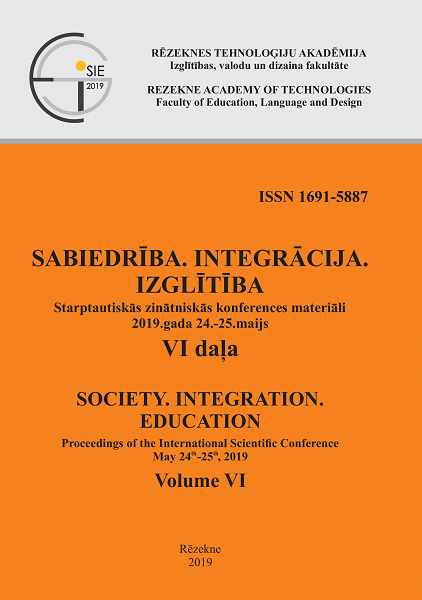CRITERIA AFFECTING CUSTOMERS' CHOICE: THE CASE OF REZEKNE CITY CATERING COMPANIES
DOI:
https://doi.org/10.17770/sie2019vol6.3732Keywords:
catering companies, customer satisfaction, customer choice, criteria affecting choiceAbstract
Increase of the number of catering businesses is driven by the growing demand, since more and more people choose eating outside. This is encouraged both by the rising welfare level and by a shift of the paradigm manifesting the diner as a place to socialize. However, from the perspective of the company, it is important to identify the main reasons why customers choose a particular eating-place. The aim of the paper is to explore the criteria influencing customers' choice and to test these criteria applying them to Rezekne city catering companies. As a result, it has been concluded that there are many criteria reviewed in the theoretical literature that could help a company to determine the criteria influencing the customers' choice. The paper is written within the framework of the RTA scientific grant "Quality Assessment of Rezekne City Catering Companies". Within the grant project, an expert questionnaire had been developed to carry out a quality assessment of Rezekne city catering enterprises. Consequently, the authors had an interest to explore the reasons motivating customers to choose a particular Rezekne city catering company according five criteria: location, offer, quality of food and drinks, company's image, and staff. As a result, the authors conclude that the most important criteria among the respondents was the quality of food and drink, as well as the offer, though, the evaluation varies depending on the particular company's specifics. The main research methods are monography, logically constructive, graphic, sociological.
Downloads
References
Akbar, Y.A.A.,& Alaudeen, M.S.S. (2012). Determinant of factors that influence consumer in choosing normal full-service restaurants: Case in Seri Iskandar, Perak. South East Asian Journal of Contemporary Business, Economics and Law,1(4),137-145.
Andaleeb, S. S., & Conway, C. (2006). Customer satisfaction in the restaurant industry: an examination of the transaction-specific model. Journal of Services Marketing, 20(1), 3-11.
Anderson, T.D., & Mossberg, L. (2004). The Dining Experience: Do Restaurants Satisfy Customers’ Needs? Food Service Technology, 4(4), 171-177.
Auty, S. (1992). Consumer choise and segmentation in the restaurant industry. The Service Industries Journal, 13(3), 324-339.
Hening-Thurau, T., & Klee, A. (1997). The impact of customer satisfaction and relationship quality on customer retention-a critical reassessment and model development. Psychology& Marketing, 14(8), 737-765.
Hensley,R.L., & Sulek, J.M. (2004). The relative importance of food, atmosphere and fairness of wait: The case of a full service restaurant. Cornell Hotel and Restaurant Administration Quarterly, 45(3), 235-247.
Infosurv Research (2017). Restaurant Customer Satisfaction Survey. Retrieved from https://www.infosurv.com/restaurant-customer-satisfaction-survey/
June, L.P., & Smith, S.L.J. (1987). Service attributes and situational effects on customer preferences for restaurant dining. Journal of Travel Research, 26 (2), 20-27.
Kafel, P., & Sikora, T. (2013). The usage of quality management methods and tools in food sector organizations. Food Science Techology Quality, 1 (86), 204-216.
Kim, W.G., & Moon, Y.J. (2009). Customers’ cognitive, emotional and actionable response to the service scape: A test of the moderating effect of the restaurant type. International Journal of Hospitality Management, 28 (1), 144-156.
Kotler, Ph. (1997). Marketing Management. Analysis, Planning, Implementation, and Control. New Jersey: Prentice Hall International, Inc., Upper Saddle River.
Lewis, R. (1981). Restaurant adversising:appeals and customers’ intentions. Journal of Advertising Research, 21 (5), 69-74.
Martin, R., & Frumkin, P. (2005). Consumer trends: What do they want (and Why)? International Journal of Contemporary Hospitality Management, 39 (21), 58-63.
Medne, L. (2004, January). Pakalpojumu kvalitātes izpratne. Gastromāns, 1(2), 64.
Parsa, H.G., Self, J.T., Njite, D., & King, T. (2005). Why restaurants fail. Cornell Hotel and Restaurant Administration Quarterly, 46 (3), 304-323.
Raosoft, Inc. (2004). Sample size calculator. Retrieved from http://www.raosoft.com/samplesize.html
Rēzeknes pilsētas dome. (2018, Novembris). Skaitļi un fakti. Pieejams: http://rezekne.lv/skaitli-un-fakti/#link_acc-1-3-d.
Scientific Psychic (2019). How to choose a restaurant. Retrieved from https://www.scientificpsychic.com/alpha/restaurants.html
Upadhyay, Y., Singh, S.k., & Thomas, G. (2007). Do people differ in their preferences regarding restaurants? An exploratory study. Vision. The Journal of Business Perspective, 11(2), 7-22.
Walker, J.R. (2014). Exploring the hospitality industry. Harlow:Pearson.
Yuksel, A., & Yuksel, F. (2002). Measurement of tourist satisfaction with restaurant services: A segment-based approach. Journal of Vacation Marketing, 1(9),52-68.


